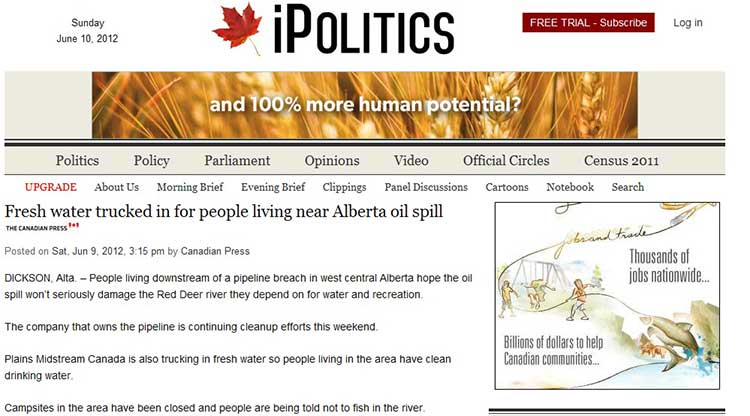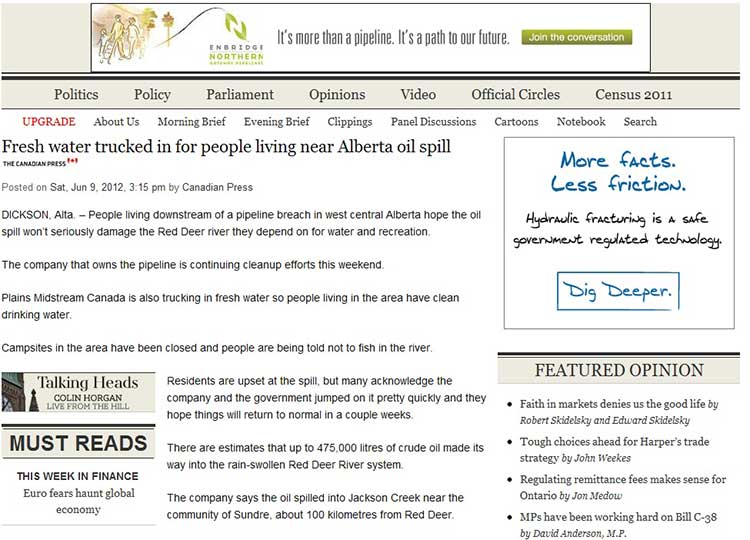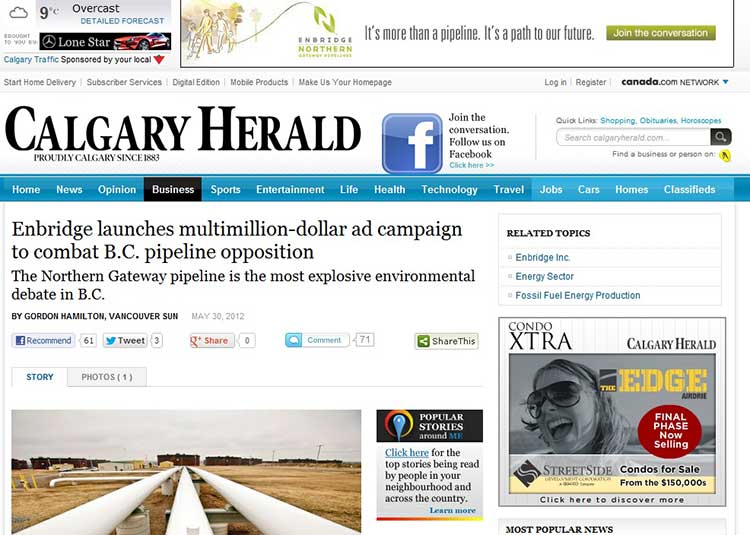As the people near Sundre, Alberta deal with an oil spill of up to 175,000 litres into the Red Deer River, there have been reports on Twitter all day of Enbridge’s pro-pipeline ads appearing alongside stories on the oil spill on news sites across Canada. For most of Saturday, I didn’t see any Enbridge ads on the news pages I checked. Ad viewing is usually tied by algorithms to the specific viewer’s interests.
Tonight, an Enbridge ad did show up on my computer screen. An unfortunate pairing of a CP story on Ipolitics.ca that drinking water will be trucked into the affected communities. Alongside it the animated Enbridge ad promoting the Northern Gateway.
Water supply is a critical issue in the Enbridge debate, especially in Kitimat, BC, where the pipeline will cross the Kitimat River watershed and then follow the route of the Kitimat River to the planned terminal at the town’s waterfront. The environmental group Douglas Channel Watch says its studies show that a major rockfall or landslide could cut Kitimat’s water supply for up to four years, meaning the town would have to survive on bottled water for years. Enbridge has said its studies and engineering will ensure the water supply is safe.
But it get’s worse. I had written this story and went back to the original Ipolitics.ca story to double check the facts and the URL The page had automatically refreshed and a new Enbridge ad appeared as a banner ad. In the right-hand box where the previous Enbridge had been a few moments before, there is now an advertisement promoting the safety of fracking.
Advertisers want interested eyeballs and various cookies and tracking mechanisms mean that these days that ads appear either in a story that is tied to the industry, in this case, oil and gas, or tied to the viewers’ web history.
In all the years I worked in television news, there were always protocols for pulling suddenly and unexpectedly inappropriate ads from a local, network or cable newscast when there was “breaking news.”
It’s a lot harder to do that for a web ad, but it can be done. It may that with Enbridge spending millions of dollars on ads, management was reluctant to stop the campaign cold. But ads can e pulled. The fact the ads are running on the second day of the spill raises again the question of Enbridge’s managerial competence. After all, the American Petroleum Institute, the lobby group for the American energy industry, immediately stopped all pro-drilling ads within hours of realizing that the BP spill in the Gulf of Mexico was a major incident.
(Note this site has no control over the Google ads which appear, which are even more than most ads, are tied to Google’s tracking of an individual’s viewing habits as well as the content of the story. Major banner ads, like Enbridge’s, however, are usually booked through web ad agencies and can be pulled by clicking a mouse.)
And yes, when I checked the facts on the ad campaign, finding a story from May 30, in the Calgary Herald, the Enbridge ad was there as well.
In the story, picked up from the Vancouver Sun, Enbridge spokesman Paul Stanway was quoted:
“You are going to see a much higher visibility for Enbridge over the next few days. In newspapers, in television and online,” said Paul Stanway, manager of Northern Gateway communications for Enbridge. “It’s become quite apparent that the debate has become a province wide issue.”
Note, due to those algorithms, if you click on the original pages, you may or may not see the Enbridge ads, just I didn’t see the ones earlier today that were linked to from Twitter.


